Note: This page is under construction. Last update 08.09.2021
The need for Bass Management (done right)
While this article about bass management gets technical very quickly it is targeted at audio enthusiasts and professionals alike. It tries to answer what bass management is, why it is useful, describes common issues and pitfalls, how it is interconnected with other aspects of audio reproduction and how it can be improved in the future.
The need for bass management
When it comes to faithful low bass reproduction 99% of all speakers aren't up to the task, even very expensive ones. What?! Unfortunately that's the ugly truth and the reason is physics and how our hearing works.
Even older studies from the CD era have found that recordings contain low frequencies down to 12.5Hz [1]. These days low frequency content is found everywhere. In order to reproduce that content it needs to be louder than the threshold of audibility. At low frequencies that threshold is extremely high. For example a 10Hz tone needs to play at around 100dB SPL to be audible at all. Someone shouting at you at 100dB will make you want to cover your ears. The reason for this discrepancy is the non-linear behavior of our hearing.
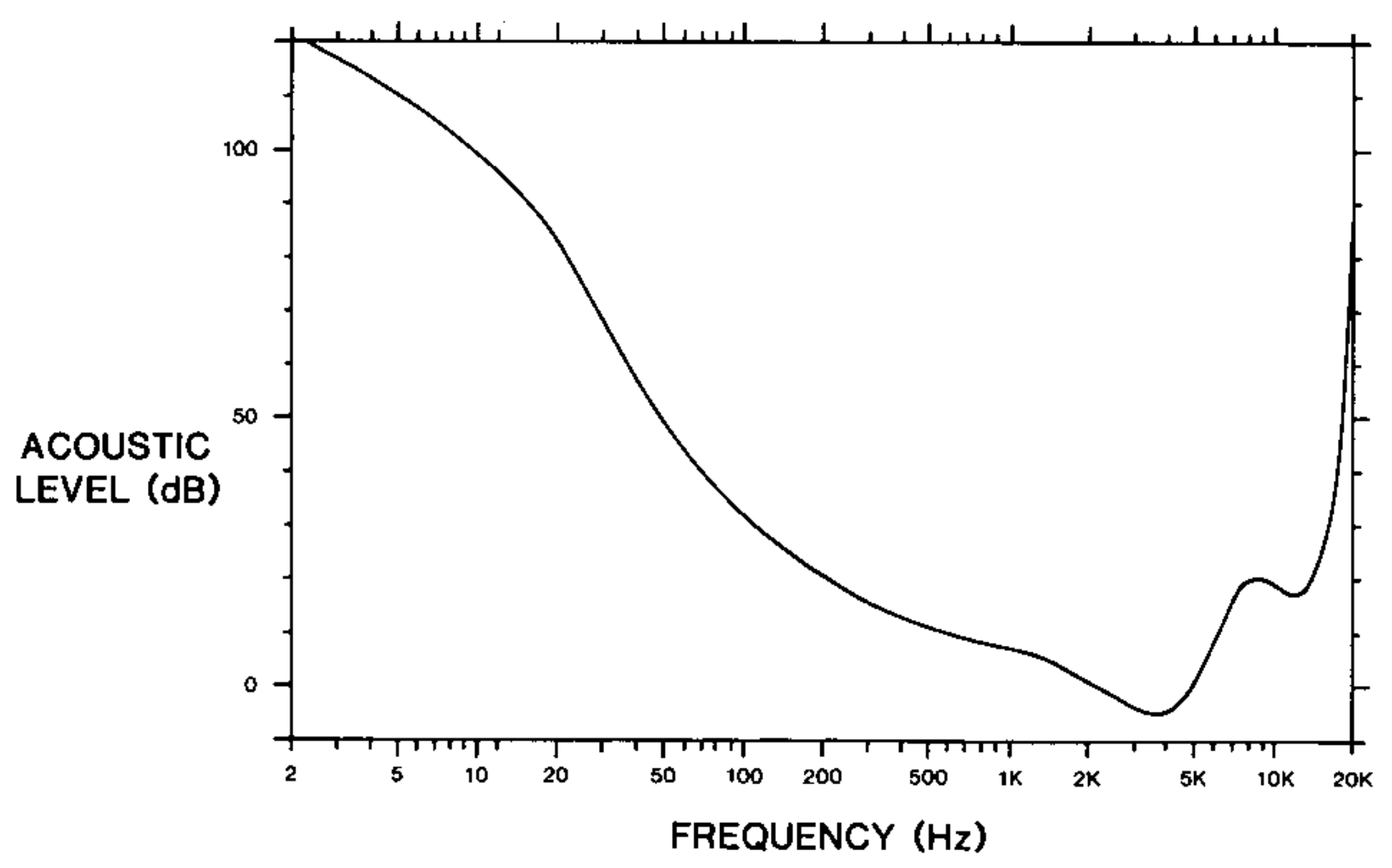
So what does that mean for a real loudspeaker? Fielder/Benjamin did the calculations for 100dB peak level capabilities at 20Hz [1]. Note, this is 5dB below the requirements for movie reference level of 105dB SPL (sound pressure level). They found a 12" driver would need to be able to move 13.5mm without producing audible distortion. This is a lot.
Talking about movie reference level, the peak level in the LFE channel is even 10dB higher than in other channels (because the LFE channel is monitored 10dB louder than other channels during mixing). This translates to 115dB SPL peak level capabilities. Even with the quite substantial advancements in speaker driver design in the last few decades this disqualifies the majority of loudspeakers from being capable of delivering that kind of performance.
At home listening levels are usually 10dB or more below movie reference level but this doesn't necessarily lower the performance requirements for a speaker as compensating for equal-loudness requires quite a substantial boost at lower frequencies, so does room equalization.
One solution to this problem is to use a single, purpose-built speaker that can handle the performance requirements for low frequency reproduction. The "subwoofer" concept was born.
Now how do we redirect all low frequencies to that subwoofer so the main speakers don't need to work that hard anymore? Somehow the low frequency content of all channels needs to be stripped and summed into a single channel, the subwoofer channel. This can be done by using a crossover, i.e. splitting a channel's signal, applying low-pass and high-pass filters and sending the result to the corresponding outputs, the main speaker and the subwoofer.
Usually SSP's (surround sound processors) offer setting speakers to "large" or "small". "Small" simply means "crossover on" whereas "large" means "crossover off".
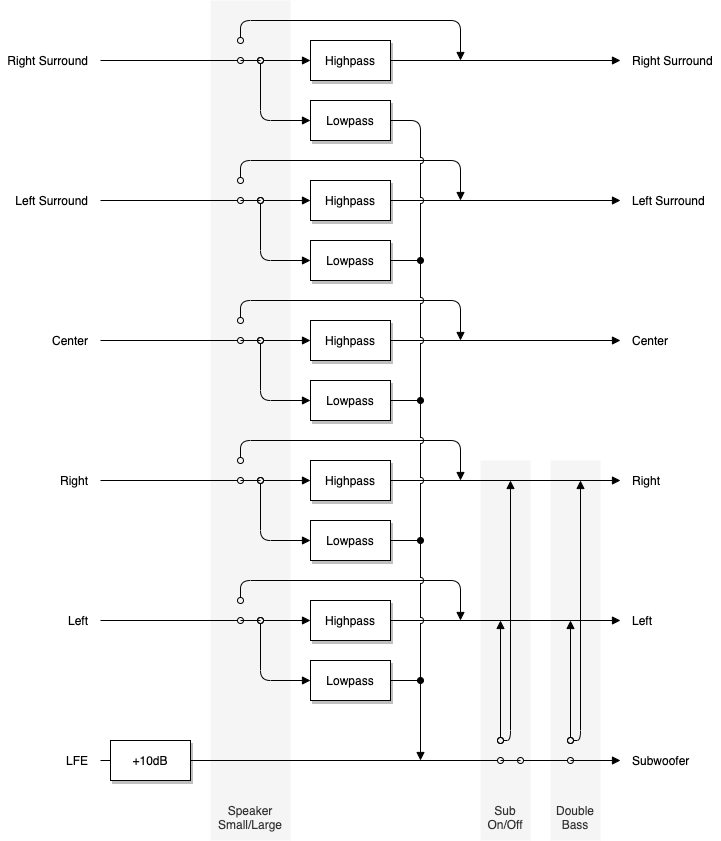
Psychoacoustic studies have found that our hearing is incapable of locating low frequency sound sources in acoustically small rooms [2]. This is true for frequencies below about 60-80Hz. First of all this eliminates the need for stereo subwoofers and secondly, it allows us to place the subwoofer anywhere in the room. But why would we want to do that? The reason is "modal ringing".
In rooms sound waves superimpose on one another in a way that leads to fixed locations with increased volume whereas at other locations volume is decreased. While there are many thousand modes at higher frequencies there are fewer modes at lower frequencies and they are spaced further apart in frequency. Depending on where you're sitting some bass frequencies sound much louder and decay slower whereas at other frequencies bass seems to be missing.
By placing the subwoofer at the right location some of the detrimental effects of modal ringing can be greatly reduced [3].
But why stop there and use only one subwoofer when the monophonic subwoofer signal from bass management could be sent to multiple subwoofers? This is indeed a good idea as placing multiple subwoofers at the right locations can smooth the response, reduce seat to seat differences over a larger listening area and increase SPL capabilities [4]. Quite beneficial for home theaters with multiple seats.
Design considerations
1. Up to this day SSP's implement high-pass and low-pass filters that have different slopes. The high-pass on the satellite speakers is usually a 12dB/octave filter whereas the low-pass is a steeper 24dB/octave filter. The rational is that satellite speakers naturally roll-off at 12dB/octave so the additional 12dB/octave from the bass management filter would make it 24dB/octave and match the 24dB/octave low-pass filter for the subwoofer.
There are two problems with that notion. Firstly, real speakers don't follow the roll-off assumption close enough (although THX-certified speakers in the past did). Secondly, what we hear at lower frequencies is not the anechoic response of a speaker but largely just the response of the room. The difference is quite dramatic.
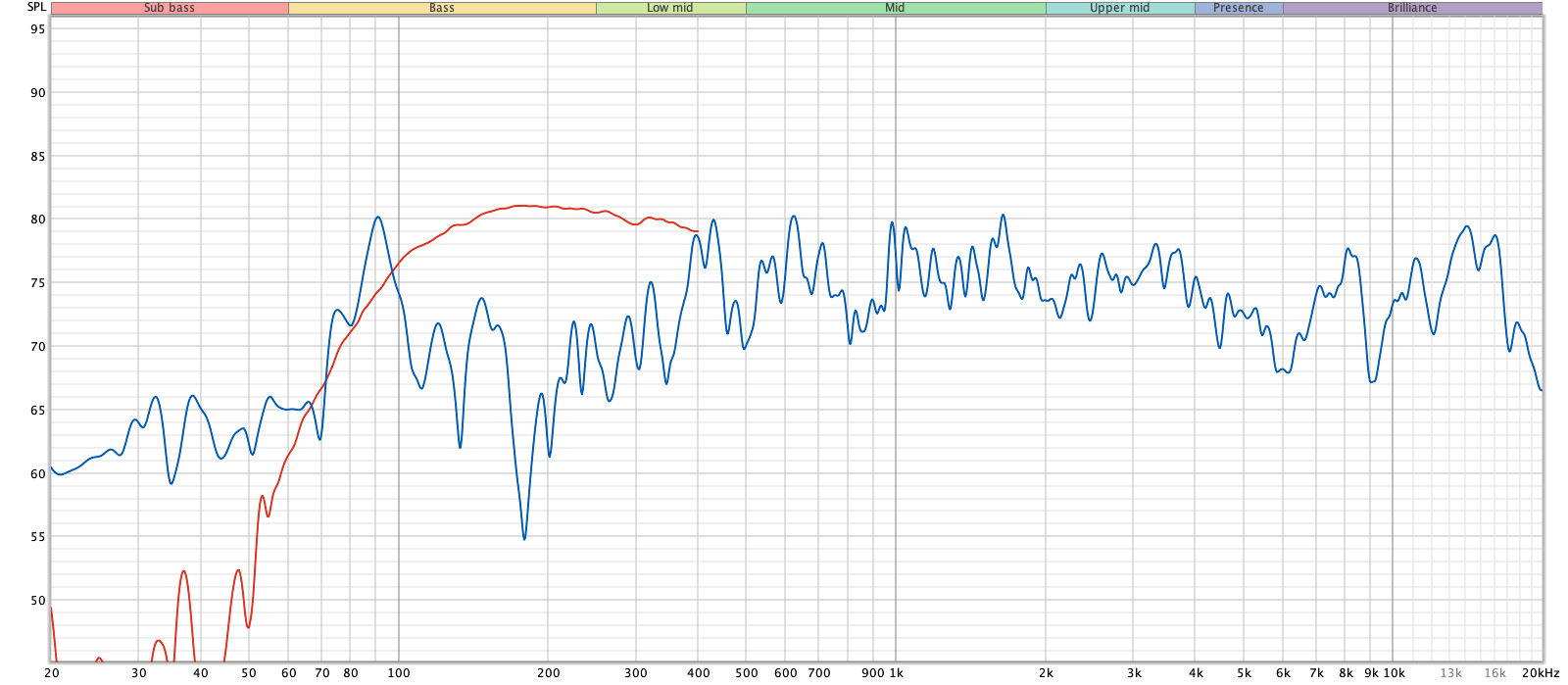
Usually Butterworth filters are used. The issue here is that these don't sum to flat but result in a 3dB hump around the crossover frequency. A better choice are 4th order Linkwitz-Riley filters (LR-4) which are created by cascading two Butterworth filters. They have a flat sum albeit the low pass section is delayed by 360 degrees.

2. Often differing speaker models are used in a multichannel configuration. Depending on their location in the room the fall-off frequency can differ dramatically. So most SSP's offer variable crossover frequencies per speaker pair. This creates two issues. Firstly the phase relationship between adjacent speaker channels is disturbed. This leads to magnitude response distortions whenever sounds are panned through these two speakers. Secondly the altered phase response leads to comb filter effects in the subwoofer channel when driven with similar content in the crossover region.
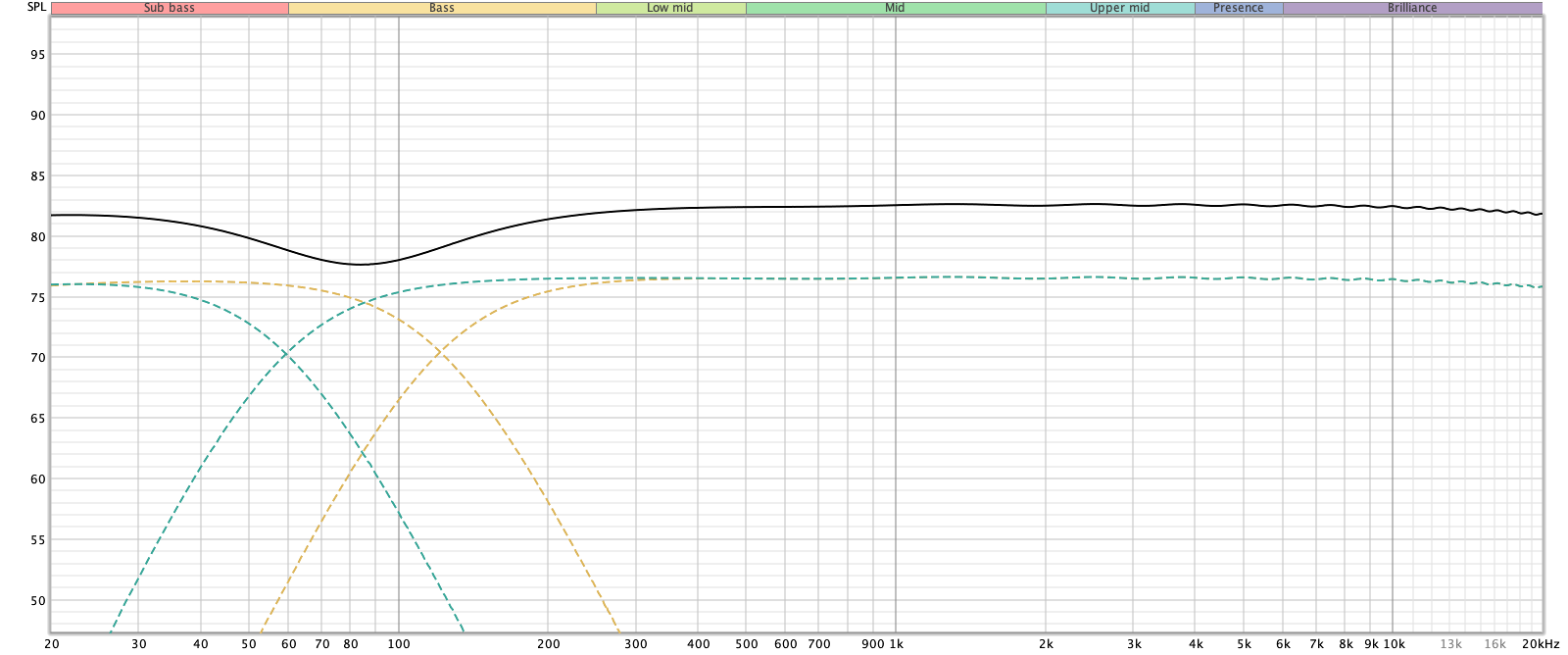
These comb filter issues can be avoided when all speakers use the very same crossover frequency. In order to get there quite some effort can be necessary to find the right speakers and speaker locations. It likely also requires acoustic treatments which at low frequencies are rather bulky or even part of the wall construction.
3. Bass management usually allows a mixture of large and small speakers. This means the phase of the small speaker signal is altered but not the phase of the large speaker signal. When combined there will be cancellation effects in the summed signal response.
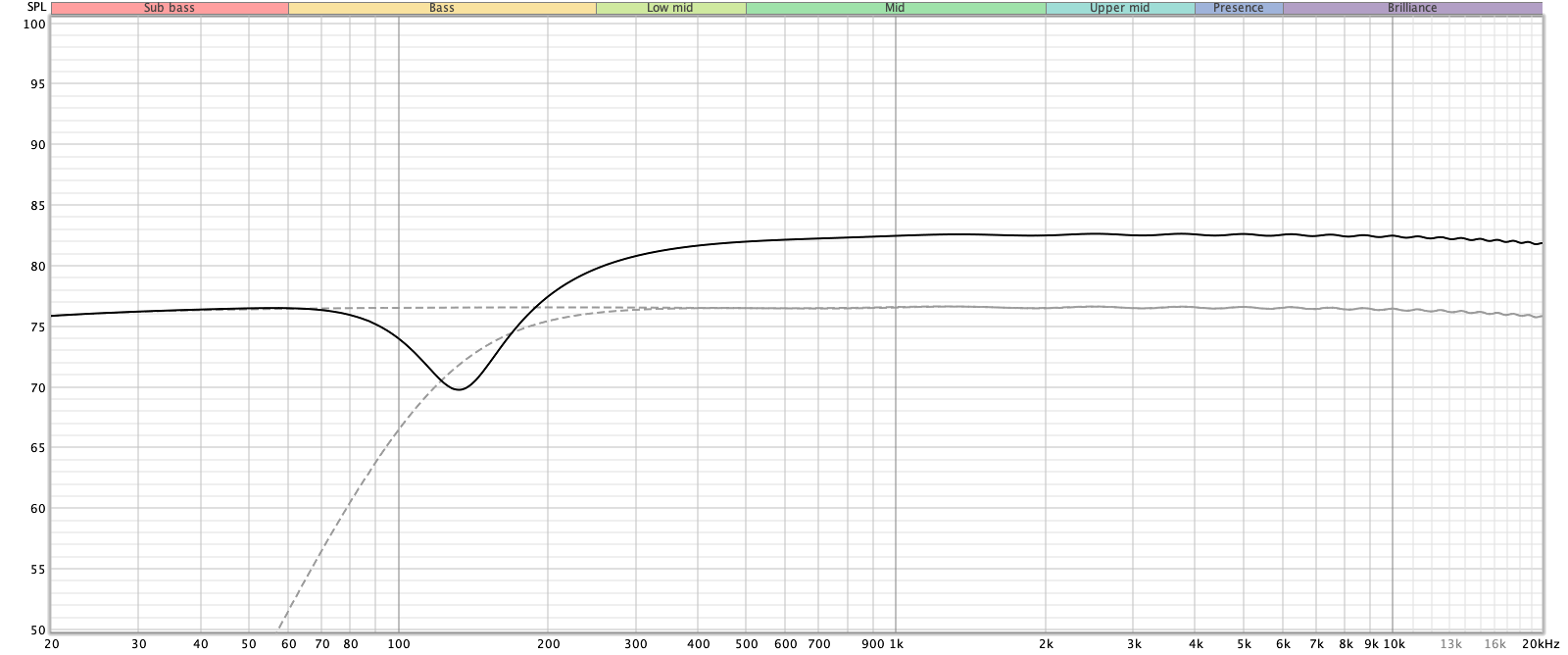
4. Downmixing the low frequency part of all channels into a single subwoofer channel and combining it with the 10dB louder LFE channel can have a dramatic impact on the signal to noise ratio (SNR) of a SSP.
Let's assume a 7.1 system. Here the worst case scenario is all 7 channels and the LFE contain a coherent full scale signal. Applied to movie reference level of 105dB SPL for each satellite speaker channel and 115dB SPL for the LFE channel, the result is 125dB SPL (7 x 105dB + 115dB). In order to cater to this headroom requirement the signal level of all bass going into the subwoofer channel would need to be reduced by a whopping 20dB in the DAC. While this is a lot the loss of SNR doesn't have as much of an audible impact as the response of a subwoofer substantially rolls off at higher frequencies, attenuating hiss in the noise floor of the DAC and analog output stages. Furthermore our ability to hear noise in the bass frequencies is reduced due to lower hearing sensitivity as illustrated in Fig.1.
5. Because bass management "unlinks" the high and low frequencies of a channel it becomes important at what point additional processing steps are performed within the signal flow. A lot of faulty implementations have found their way into SSP's. Here are some examples.
Speaker distance setting applied upstream of bass management:
Sound emanating from non-equidistant speakers arrives at the main listening position at different times. This leads to imaging issues. By delaying the closer speaker the difference in arrival time can be removed. Proper imaging is restored.
If this delay is applied upstream of bass management it will lead to strong cancellation effects in the redirected low frequency signals that go to the subwoofer. This issue can be avoided by placing speaker delay downstream of bass management.
Tone control applied downstream of bass management:
The tonal balance of recordings can vary quite dramatically, especially at low frequencies. This is caused by the low frequency room response in mixing studios which is anything but consistent [5]. Furthermore when overall volume is reduced the perceived level of lower frequencies falls off quicker than the level at higher frequencies due to the non-linear behavior of our hearing. Turning up (or down) just lower frequencies can restore the tonal balance. So a bass tone control that can be adjusted on the fly is a good idea.
If this control is applied downstream of bass management then only the signal going to the satellite speakers is affected, not the subwoofer channel. Hence tone controls need to be applied upstream of bass management.
Channel volume controls applied downstream of bass management:
Sometimes there's an imbalance between front speakers and surrounds or speech in the center channel is too low. A speaker level control would come in handy.
Virtually every SSP uses the speaker channel trims for this. Unfortunately this leaves the redirected low frequency content going to the subwoofer untouched.
The right way to do this in a bass managed system is to apply individual channel volume controls upstream of bass management.
Generally all processing concerning only the individual channels should be happening upstream of bass management. All processing concerning the individual speakers should be applied downstream of bass management.
Bass management schemes
1. No subwoofer
Here LFE gets routed to the left and right speaker. This is not a desirable setup as the left and right speaker likely don't have the required low frequency capabilities. Furthermore they are placed at locations that are optimized for good imaging, not for best low frequency response. The response will vary quite dramatically depending which speaker or speaker combination gets to reproduce low frequency sounds. This solely depends on the recording.
This scheme allows other speakers to be set to small, i.e. all low frequency content from these speakers is routed to the left and right speakers which will overload them even more. Although this reduces the number of independent low frequency sources the low frequency response still varies with content. Sounds can be in the left channel, the right channel or any combination, including any speaker set to large. Furthermore summing unfiltered channels with channels that have been low/high-pass filtered will create cancellation effects. Highly undesirable.
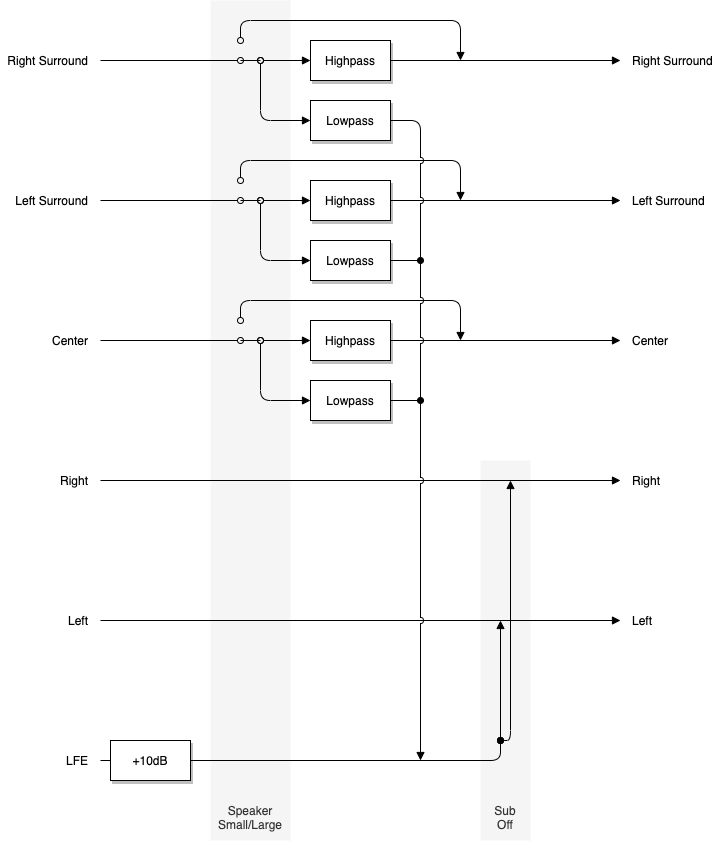
2. Large with subwoofer
When all speakers are set to large the subwoofer receives only the LFE channel. This scheme corresponds to how movies are mixed and monitored in a dubbing stage. While one might think this is more true to the original, most movie content these days undergoes a bass managed remix before getting distributed for broadcast, internet streaming or Blu-ray. There are no direct theater to home cinema transfers.
This scheme often also allows other speakers than left and right to be set to small, i.e. all low frequency content from these speakers is routed to the subwoofer. While these channels can now be optimized there's still signals that are either just in one speaker set to large or any combination of large speakers. Like above this solely depends on the recording. Low frequency response will therefore become unpredictable. There's also cancellation effects from summing unfiltered and low/high-pass filtered channels.
There is a widely available feature in SSP's called "double bass", "LFE + mains" or similar. Here the redirected low frequency content from speakers set to small is not only routed to the subwoofer but also to the left and right speaker. As we'll see later mixing back redirected low frequency content into speaker channels could actually be useful if implemented differently but here it contributes to overloading the left and right speaker and an unpredictable low frequency reponse depending on the recorded content. Highly undesirable.
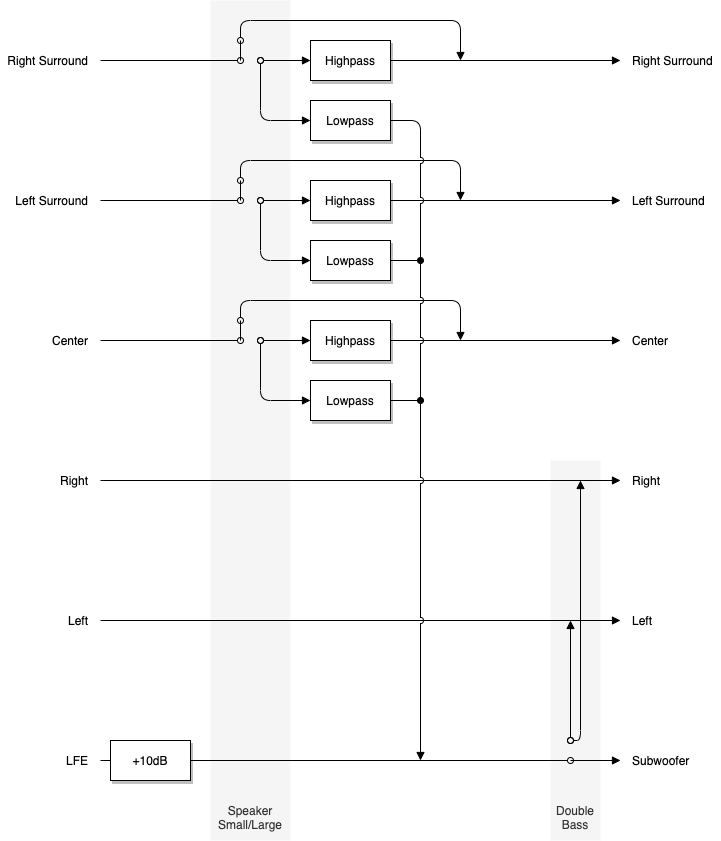
3. All small with subwoofer
This is the most desirable configuration. The subwoofer can be freely placed for optimum performance. Furthermore the low frequency performance is now independent of recorded content. The subwoofer signal will stay optimized regardless which channel or channel combination contains low frequency signals.
There are no cancellation effects from summing unfiltered and low/high-pass filtered channels. And if a single crossover frequency can be maintained for all speakers there are no phase issues at all.
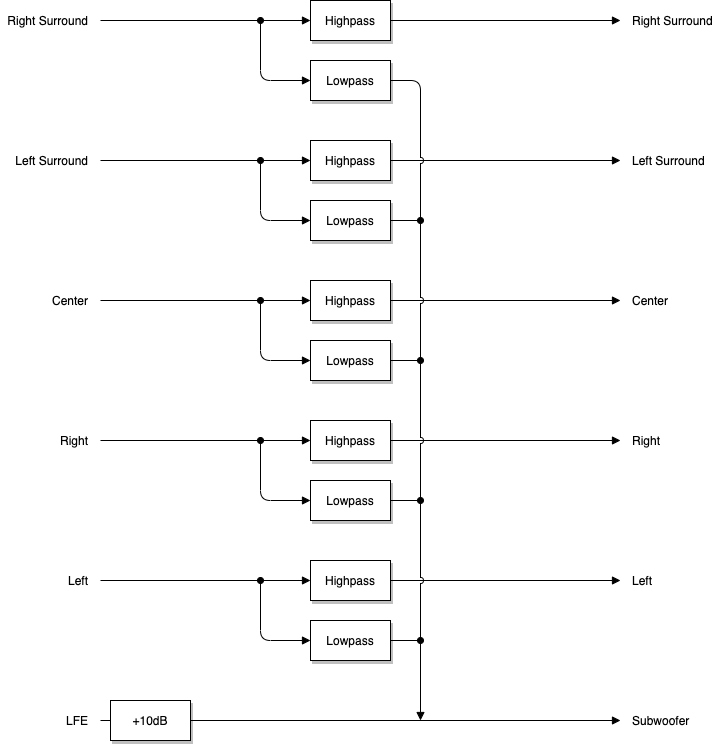
4. Small with virtual subwoofer
There are speakers with large woofers or even built-in subwoofers. They might have the required performance capabilities but still, they are placed for best imaging and not for best low frequency reproduction. On the other hand, if there are 5, 7 or even more of these speakers in the room and if they are correctly optimized, it is very likely that low frequency performance can be improved considerably.
For this to work all speakers need to act like a single subwoofer, i.e. they simultaneously need to receive a monophonic subwoofer signal. This can be achieved by applying a regular "all speakers small with subwoofer" scheme. But this time the subwoofer signal isn't routed to a dedicated subwoofer, it is mixed back into the individual speaker signals.
Unfortunately there's no SSP in the marketplace that would allow such kind of processing.
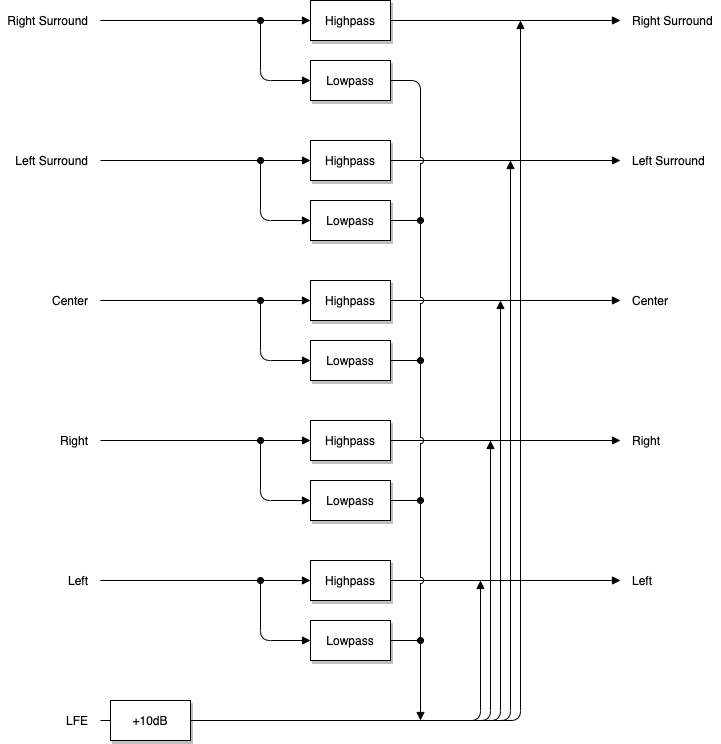
References
[1] Louis D. Fielder and Eric M. Benjamin, "Subwoofer Performance for Accurate Reproduction of Music", J. Audio Eng. Soc., Vol. 36, No. 6, 1988 June
[2] William L. Martens, Jonas Braasch and Wieslaw Woszczyk, "Identification and discrimination of listener envelopment percepts associated with multiple low-frequency signals in multichannel sound reproduction", Audio Engineering Society Convention Paper 6229, 2004
[3] Jan Abildgaard Pedersen, Kjeld Hermansen and Per Rubak, "The Distribution of the Low Frequency Sound Field and its Relation to Room Equalization", presented at the AES 96th convention, Amsterdam, 1994, February 26 - March 01. Preprint number 3852.
[4] Todd Welti, "How Many Subwoofers are Enough", Audio Engineering Society Convention Paper 5602, 2002
[5] Aki V. Mäkivirta and Christophe Anet, "The Quality of Professional Surround Audio Reproduction, A Survey Study", 19th International Conference, Audio Eng. Soc., Paper 1914, 2001
Acknowledgments
Roger Dressler for proofreading and contributions.